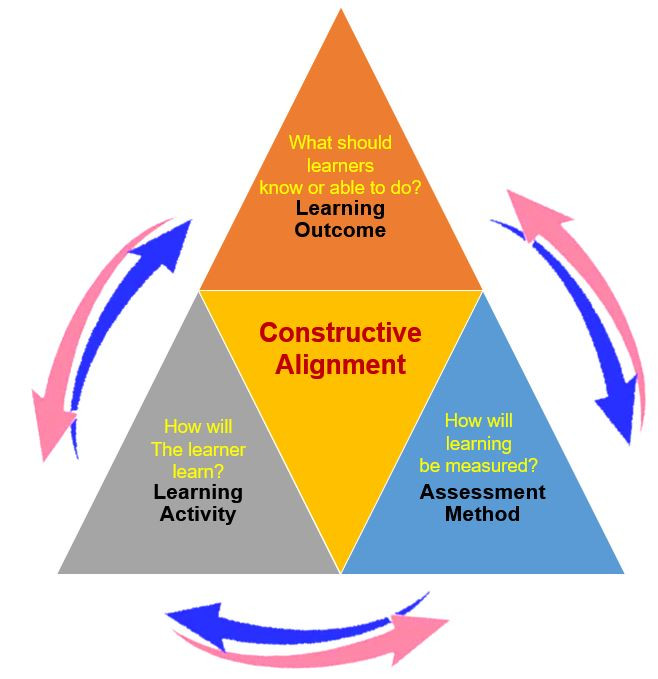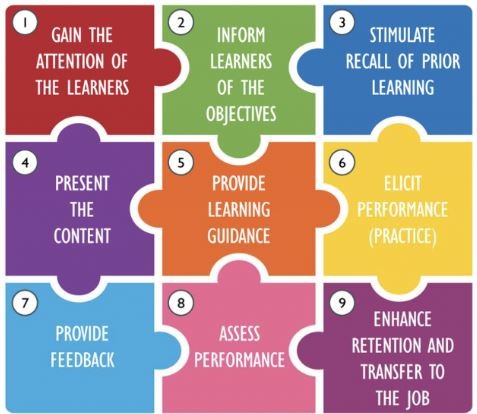Constructive Alignment - 建设性一致
According to Dr. Stephen R. Covey, all things are created twice.
- first in mind and then in the real world.
Physical creations follow mental ones, just like Learning deliverables and outcomes are planned according to learning objectives, and homes are built according to blueprints. To make your deepest desires a reality, you first need to see and understand what those desires are. To begin with the end in mind is to visualize your life, career, lesson, or specific sales project the way you want it to be before you start pursuing it. When you make this conscious effort, you control your life and circumstances much more.
“Begin with the end in mind” philosophy is so important. They are clarity, efficiency, and purpose, and let’s take a closer look at each.
Clarity - When you understand where you want to end up, you’ll gain tremendous clarity in many areas of your life. For example, if you realize that your greatest training goal is to impart to your learner the skills and knowledge to conduct the full cycle CPR with DRSABC steps confidently to save a life, the steps to achieving this end become clear.
First, you have to develop a Lesson plan with few learning outcomes. Then you need to create your learning and teaching activity, get the learner to practice and demonstrate back, find a scenario to assess their ability to perform, etc.
The steps you take will be unique to your vision, but the general aspects of mastering the CPR skill remain. When you begin with the end in mind, you’ll also gain clarity about what NOT to do and pursue.
Efficiency - When you begin with the end in mind, you gain clarity, which will naturally help you become more efficient. You’ll be able to plan and strategize for the best route to your goals. Let’s say your learner wants to become a bakery within the next two weeks. That’s his and your goal as a trainer. You can now plan out the most efficient lesson plan and learning activities to help your learner to achieve it. Instead of chasing erroneous objectives, you’ll focus on the steps you need to take to engage the learner with the knowledge and practical-based activity to ensure they can “Show-Me” and deliverable.
Purpose - You gain meaning when you begin with the end in mind. You’ll be chasing meaningful goals, building a career you can be proud of, and living the kind of life you want. Many find that they lack fulfillment because they chase other people’s goals without realizing them. Not everybody wants to be a rich and famous millionaire or coach, or be the CEO of a company, or have a vacation home in Italy — at least not enough to put in the work required. Many people would rather live a quiet life with the people they love. There’s nothing wrong with that! The key is focusing on what you want and working to achieve it. That’s how you gain purpose and fulfillment.
根据 Stephen R. Covey 博士的说法,所有事物都被创造了两次。
- 首先在脑海中,然后在现实世界中。
物质创造遵循精神创造,就像学习成果和结果果是根据学习目标计划的,家园是根据蓝图建造的。 为了让你最深切的愿望成为现实,你首先需要看到并理解这些愿望是什么。 以终为始就是在你开始追求之前,按照你想要的方式想象你的生活、职业、课程或特定的销售项目。 当您做出这种有意识的努力时,您可以更好地控制自己的生活和环境。
“以终为始”的理念非常重要。 它们是清晰度、效率和目的性的,让我们仔细看看每一个。
清晰——当你明白你想在哪里设下终点时,你会在你生活的许多方面获得巨大的清晰度。 例如,如果您意识到您最大的培训目标是向您的学习者传授急救技能和知识,以便自信地使用 DRSABC 步骤进行全周期心肺复苏以挽救一条生命,那么实现这一目标的步骤就会变得清晰。
首先,你必须制定一个学习成果的课程计划。 然后你需要创建你的学习和教学活动,让学习者练习和演示,找到一个场景来评估他们的执行能力,等等。
显然,您采取的步骤对于您的愿景来说是独一无二的,但掌握 CPR 技能的一般方面仍然存在。 当你以终为始时,你也会清楚什么是不该做和不该追求的。
效率——当你以终为始时,你会变得清晰,这自然会帮助你变得更有效率。 您将能够规划和制定实现目标的最佳途径。 假设您的学习者希望在接下来的两周内成为一家面包师傅。 这是他和你作为教练的目标。 您现在可以规划出最有效的课程计划和学习活动,以帮助您的学习者实现它。 您不会追逐错误的目标,而是关注您需要采取的步骤,让学习者参与知识和基于实践的活动,以确保他们能够“展示给我看”和交付成果。
目的——当你以终为始时,你就会获得意义。 您将追逐有意义的目标,建立您可以引以为豪的职业,并过上您想要的生活。 许多人发现他们缺乏成就感,因为他们在没有意识到的情况下追逐别人的目标。 不是每个人都想成为富有和著名的百万富翁或教练,或者成为公司的首席执行官,或者在意大利拥有度假屋——至少不足以投入所需的工作。 很多人宁愿和自己爱的人过平静的生活。 这没有错! 关键是专注于您想要的并努力实现它。 这就是您获得目标和成就感的方式。
"Constructive alignment is a design for teaching in which what intended learners should learn and how they should express their learning is clearly stated before teaching takes place. Teaching is then designed to engage learners in learning activities that optimise their chances of achieving those outcomes, and assessment tasks are designed to enable clear judgments as to how well those outcomes have been attained" (Biggs, 2014, pp. 5-6).
The constructive alignment approach recognises "knowledge is constructed by the activities of the learner" (Biggs, 2014, p. 9) rather than being directly transferable from teacher to learner. "Learning takes place through the active behavior of the learner: it is what he does that he learns, not what the teacher does." (Tyler, 1949)
Alignment occurs when the learning activities we ask learners to engage in help them develop the knowledge, skills, and understandings intended for the unit and are measured by our assessment. A constructively aligned unit capitalises on the powerful effect of evaluation on learners' learning experiences. If assessment drives learners' learning, then learners will most likely achieve our intended outcomes if the review aligns with our intentions.
The framework of constructive alignment is represented in the University's recommended approach to unit design:
• Identify the intended learning outcomes
• Design assessment tasks to measure the attainment of the learning outcomes
• Plan learning activities to enable students to develop the skills, knowledge, and understandings described in the intended learning outcomes and measured by assessment
• Choose the content (topics/examples/resources/materials) required to support the learning activities
Example:
To conduct a CPR course, at the end of the lesson, the learner should be able to
LO1 – Describe the difference between heart attack and cardiac arrest (Learn Activity – Group Discussion on self-reading or write from a video and assess through the Oral or written test)
LO2 – identify the four symptoms of cardiac arrest (Learn Activity – Group Discussion on self-reading or write from a video and assess through the Oral or written test)
LO3 – Perform a complete cycle of DRSABC step of CPR to rescue a life (Learn Activity – Demonstration (inc watch video learning) with Practice and assessment through the practical test)
“建设性一致是一种教学设计,在教学开始之前,明确说明预期的学习者应该学习什么以及他们应该如何表达与呈现他们的学习结果。然后,教学旨在让学习者参与学习活动,以优化他们实现这些成果的机会,并且 评估任务旨在明确判断这些结果的实现情况”(Biggs,2014 年,第 5-6 页)。
建设性一致方法承认“知识是由学习者的活动构建的”(比格斯,2014 年,第 9 页),而不是直接从教师转移到学习者。 “学习是通过学习者的主动行为发生的:他学习的是他所做的,而不是老师所做的。” (泰勒,1949 年)- 例如观看视频学习,小组讨论
当我们要求学习者参与的学习活动帮助他们发展该单元的知识、技能和理解力并通过我们的评估来衡量时,就会发生一致性。 一个建设性的协调单元利用评估对学习者学习体验的强大影响。 如果评估推动学习者的学习,那么如果审查符合我们的意图,学习者将很可能实现我们的预期结果。
建设性一致的框架体现在大学推荐的单元设计方法中:
• 确定预期的学习成果
• 设计评估任务以衡量学习成果的实现
• 规划学习活动,使学生能够发展预期学习成果中描述并通过评估衡量的技能、知识和理解
• 选择支持学习活动所需的内容(主题/示例/资源/材料)
例子:
要进行心肺复苏术课程,在课程结束时,学习者应该能够
LO1 – 描述心脏病发作和心脏骤停之间的区别(学习活动 – 小组讨论自学、读或从视频中反馈学习,并通过口试或笔试进行评估)
LO2 – 确定心脏骤停的四种症状(学习活动 – 小组讨论自读或从视频中反馈学习,并通过口试或笔试进行评估)
LO3 – 执行完整的 心肺复苏术 DRSABC 步骤循环以挽救生命(学习活动 – 演示(包括观看视频学习),通过实践测试进行练习和评估)













No Comments